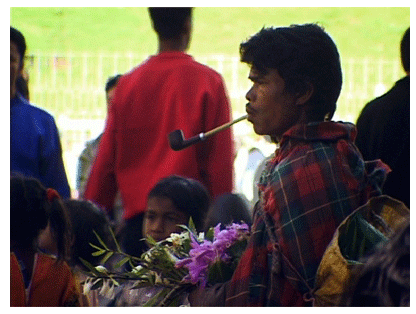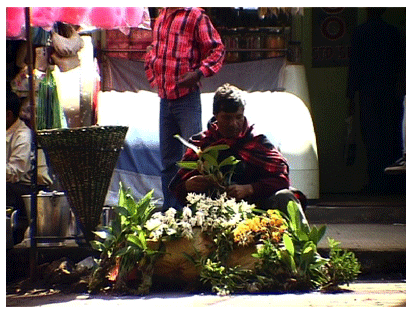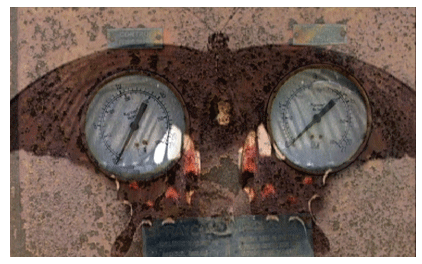- Prelude
- Editorial
- A Conversation with Sheela Gowda
- The DIY Artist with a Mission
- Discovering Novel Horizons
- A Conversation with Raqs Media Collective
- Manjunath Kamath
- Jitish Kallat- the Alchemist
- The Artist and the Dangers of the Everyday: Medium, Perception and Meaning in Shilpa Gupta's work
- An Attitude for the Indian New Media
- Weave a Dream-Theme Over Air or a Medium like Ether
- Installation in Perspective: Two Outdoor Projects
- Towards The Future: New Media Practice at Kala Bhavana
- Workshop @ Facebook
- Desire Machine: Creating Their Own Moments…
- Typography: The Art of Playing with Words
- Legend of a Maverick
- Dunhill-Namiki
- The Period of Transition: William and Mary Style
- The Beauty of Stone
- Nero's Guests: Voicing Protest Against Peasant's Suicides
- Patrons and Artists
- The Dragon Masters
- What Happened and What's Forthcoming
- Art Chennai
- Art Events Kolkata
- Winds of Change
- Art Bengaluru
- Mumbai Art Sighting
- Musings from Chennai
- In the News
- Previews
- Ascending Energy, Merging Forms: Works by Satish Gujral
- Re-visiting the Root
- The Presence of Past a New Media Workshop
- Taue Project
ART news & views
Desire Machine: Creating Their Own Moments…
Volume: 3 Issue No: 15 Month: 4 Year: 2011
by Moushumi Kandali
At the GenNext symposium ( Kolkata, 2009), where the topic was “Has art become more real and democratic after Globalisation?”, as one of the speakers of the penal discussion, I had talked about this specific strategy of setting the thief to catch the thief in some of the politically reflexive praxis adhered by the contemporary artists. If globalisation as the hydra headed phenomenon brought forth multiple implications in the last two decades, this community of artists appropriated and adopted the technological equipments and tools ushered by this very phenomenon to critique, question, mediate and negotiate dialectically those very implications embedding their (our) existential predicament. As such, it is a well known fact that in the pan Indian scenario, post 80's and 90's saw artists using new material, new structures, conceptually coded signs, bringing forth questions of art and its object-hood to a head investigating its status at the level of assembly and installation. This resulted in dismantling replete images as well as bringing in new purpose to formalist interventions, along with extended reproduction strategies like video, digital art, net art, and photocopy complimented with artist's individual performance. But these were mere lingual means and strategies to address larger issues at hand. If for the Marx- oriented camp, the complex terrain of the contemporary operating within the new paradigm of globalisation is the expansion of the capitalist system, the McDonaldization and globalization of Nothing, for some quarters, it signifies a new unified world order filled with egalitarian opportunities. However without going into much complex theoretical dialectics, we can say that the contemporary realities as such have been definitely regulated by new technologies initiating technocratic forms of politics. Precipitated by rapid advances in informational technologies, this economic-technological phenomenon has brought fourth epochal changes in political structures and social organisations, taking an uncharted course towards new, global and trans-national forms of the organisations of power. Present world in its contemporary manifestation is not simply a product of techno-scientific development, but also points to a fundamental confluence of power and technology,  to a concourse of the circuits of power and technicity of relations (social, economic, personal, and political) as pointed out by thinkers like Peter Sloterdijk, Jean-Luc Nancy and others. In view of the circumstances, a plethora of issues and questions emerge, one of which is related to the changing nature, position relationality, technicity and traits of art and aesthetics.
to a concourse of the circuits of power and technicity of relations (social, economic, personal, and political) as pointed out by thinkers like Peter Sloterdijk, Jean-Luc Nancy and others. In view of the circumstances, a plethora of issues and questions emerge, one of which is related to the changing nature, position relationality, technicity and traits of art and aesthetics.
These are the issues and questions at hand which some of the contemporary cultural practitioners attempt to address. Talking about such attempts, I had discussed about a collective which is known as the “Desire machine” in that GENNEXT symposium. Desire Machine Collective seems to work in two parallel operations, one the creative genre of research and productions of video art on various themes and issues and the other of undertaking curatorial projects such as Periphery to facilitate site/ space for interdisciplinary creative ventures and discourses on art/culture in particular and life in general in its various socio-political manifestations. Conceived by Sonal Jain and Mriganka Madhukaillya, it is a media collective based in the Northeast of India to initiate an artist's led alternative art space located on an abandoned ferry (barge) on the river Brahamaputra in Guwahati, Assam. As the initiatives by Desire-Machine translates into this particular concept of a “curatorial project” called Periferry on a ferry (a pun on the notion of centre/periphery and the subsequent notion of North-East as a peripheral pocket in the nation's imagination), it seeks to alternate the prevalent modes, predicaments and notions and wills to set the trend in the reverse order. If the trend is that of going away from the periphery to the centre, the so called “mainstream”, it dreams of bringing the centre to the periphery setting a new mode of reversal. As a nomadic space on the ferry (called Chandordinga) for hybrid practices, it aims to work as a trans-local initiative which looks at the critical uses of technology for collaborative experiments. The collective intends to call the space a “laboratory”, to promote experimentations in art, ecology, technology, media and science, and thereby create a public domain, for critical reflections. It has strived to bring together people engaged in cross disciplinary practice to create a network space (both physical and virtual) for negotiating the challenge of contemporary cultural production.
Dictated by the very strategy of setting the thief to catch the thief about which I pointed in the beginning, Desire Machine had began their journey in the midst of this decade by using post-modernist, and a conceptualist/minimalist lingual expression with medium like video and the internet. With certain attempts for critiquing various issues like politics of Identity, centre and periphery, displacement and immigrations, borders and boundaries, and various other issues concerning the local and global against the backdrop of globalisation, with specific reference to the socio-political dialectics in the North-East (works for instance, Disturbed Area Network, Notebooks on Geography, Politics of Real Time, etc.) Desire Machine operated in a quite politically reflexive interventional stance in the beginning of their journey. About Body Borders (2006, video, a single channel, 10 min loop) is a video that questions the representation of the northeast in mainstream India media as a deviant, exotic space. To tape the underlying currents in the construction/reconstruction and deconstruction of the notion of a nation and the politics of building stereotypes in social mechanism is the central concern of this video. Daily Check up (MiniDv, 2005) looks at everyday violence experienced in a region of imposed imagined geographies, pushed into the periphery of a nation's imagination. The recurrent motif of this video is a visual shot of security check up in the airport terminus. Based on the experience of extra “tactful” security check up that the youths from the north-eastern states undergo, the video posits certain questions about the representation of North-east as the terrorist states in the imagination of the nation. The hand of the security personal trailing on the body of a youth becomes a suggestive pointer of the aggressive invasion of the private space as well as the violation of the human rights by the controlling authority/ nation state in the name of maintaining law& order situation. Here the body becomes the political anatomy or a signifier of the Notebooks on Geography. Alfa Beta (MiniDv, 2005) questions the politics of representation of the northeast in mainstream Indian media. There is a re appropriation of existing representation. Textual pun playing is the rendered strategy as seen in the title itself with layered implication. Triggered with intended pun-wit-satire, Desire Machine also used footage of Popular Bollywood movies like Tango-Charlie to deconstruct the politics of construction and stereotyped representation about the North-East. DAN or Disturbed Area Network is another such take-on on the issue where North-East as an exotic Tourist space unfolds the internal contradictions. Taking out the spectator on a tourist journey it eventually bares upon the ground realities of the geopolitical space afflicted by several maladies of modernist nihilism and marginalisation.
However, Desire Machine had undergone a transition in their ideational as well as expressional mode in a subtle way in and through time in their definite discourse making their art and stance more trans-national, expansive and suggestive. Overt political reflexivity was given way to more metaphorical suggestivity, though the political layering at the core remained the same. Maya Angelou's “Personal-is-political” kind of creative gestures became predominant with doors and windows open for multiple interpretation, multiple suggestions and non-fixity of positions. Their subsequent recent works are pointer to such transition. 25/75 (2006, MiniDV), a work based on an obsessive preoccupation of  some of the people of Meghalaya called Teer (arrow), a game of betting on numbers, interpreted from dreams of the previous night, weaves the a dream like world with cut-in device of certain surrealist shots in between, as everything just seems to go by. It is a take on the slices of Reality as operative in various levels-- as a perception as well as, as a lived experience. 30/12 (2009, Mini DV) is set on a single day of an orchid seller, who goes about his daily work on the streets of Shillong, on the very day of the execution of Saddam Hussain. As one man is being executed in a far off land and one man is selling the cure for all problems in the backdrop of this “drama”, the mock-comical overlapping of the multiple realities within the Everyday Reality is explored upon both metaphysically and politically. The work entitled Passage (2006, MiniDV) seems more abstract, conceptual and surreal as a recurrent image of a overlapped passage/doorframe keeps emerging, merging and diverging in an ongoing lyrical composition being interrupted recurrently by a dark blank void and silence. The disruption, a conscious strategy to shatter the building climax in the experience of the spectator is a symbolic pointer to the construction/deconstruction and the making/unmaking of our realities at various levels which we tend to take in as the given reality without any permutations. Here, being ordered and reordered in endlessly different constellations, the detached observer follows endless exploration and search for his own reality. Perhaps, the most poignant rendering of their recent oeuvre is a 39 minute video called Residue (2010, 16mm film) which has been shot in a redundant Thermal power plant in the outskirts of Guwahati. As stated by the collective, the interest of the work is in constructed signs that can never be replicated or remembered and in the relationship between matter and memory. There is also an endless circularity and an unbearable silence the pause that punctuates the experiences. It can also be seen as an exploration to dissipate the dichotomy of man/ machine, nature/culture, the Wild and the Civilisation. With each frame poetically rendered and solemn music of Buddhist Chanting by Lama Tashi further enhancing the effect, this work excels lyrically in weaving a fine blend of the conceptual and the lingual expression.
some of the people of Meghalaya called Teer (arrow), a game of betting on numbers, interpreted from dreams of the previous night, weaves the a dream like world with cut-in device of certain surrealist shots in between, as everything just seems to go by. It is a take on the slices of Reality as operative in various levels-- as a perception as well as, as a lived experience. 30/12 (2009, Mini DV) is set on a single day of an orchid seller, who goes about his daily work on the streets of Shillong, on the very day of the execution of Saddam Hussain. As one man is being executed in a far off land and one man is selling the cure for all problems in the backdrop of this “drama”, the mock-comical overlapping of the multiple realities within the Everyday Reality is explored upon both metaphysically and politically. The work entitled Passage (2006, MiniDV) seems more abstract, conceptual and surreal as a recurrent image of a overlapped passage/doorframe keeps emerging, merging and diverging in an ongoing lyrical composition being interrupted recurrently by a dark blank void and silence. The disruption, a conscious strategy to shatter the building climax in the experience of the spectator is a symbolic pointer to the construction/deconstruction and the making/unmaking of our realities at various levels which we tend to take in as the given reality without any permutations. Here, being ordered and reordered in endlessly different constellations, the detached observer follows endless exploration and search for his own reality. Perhaps, the most poignant rendering of their recent oeuvre is a 39 minute video called Residue (2010, 16mm film) which has been shot in a redundant Thermal power plant in the outskirts of Guwahati. As stated by the collective, the interest of the work is in constructed signs that can never be replicated or remembered and in the relationship between matter and memory. There is also an endless circularity and an unbearable silence the pause that punctuates the experiences. It can also be seen as an exploration to dissipate the dichotomy of man/ machine, nature/culture, the Wild and the Civilisation. With each frame poetically rendered and solemn music of Buddhist Chanting by Lama Tashi further enhancing the effect, this work excels lyrically in weaving a fine blend of the conceptual and the lingual expression.
Desire Machine collective is perhaps the forerunner in new media work of sound installation in the north-Eastern region. Their sound installations such as Sacred is a technological "sound map" that replaces colonial map making and Trespassers Will Be Prosecuted is a nine channel site specific sound work installed in the Deutsche Guggenheim in museum, Berlin in 2008. As pointed out by them, in Sacred, the path through the protected area was precisely documented by means of GPS and in the printed version, QR codes are positioned along the trail, which can be decoded using a smart phone, thus making the original recordings audible again. Their concept note on Trespassers Will Be Prosecuted (sound installation) states, “The project seeks to summon 'false memories' via a forest soundscape. The work questions the notions of materiality in terms of the taboos and if “taking sounds” falls within the scope of the belief. It draws from the sounds collected from Law Kyntang, the sacred forest in Meghalaya that has emerged as unique ecological system based on a traditional belief system and not on any laws or regulations. Here, destruction of any plant or animal life or taking any object from this forest is forbidden. The installation's conceptual point of departure is critic / theorist of technology Paul Virilio's definition of 'space'. He points out that the limits or boundaries of the city itself have come into question, largely because of new informational and communicational technologies that introduce a novel idea of space, i.e., space as virtual, dematerialised. He also points to the relative devaluation of a physical idea of space and place”

At this point, one is however grappled with certain dialectical query as this entire issue of de-contextualisation and de-territorialisation is not without its inherent contradictions and dilemma with regard to the issue of the invasion/penetration by authoritarian forces / power structures aided and privileged by technological empowerment over those local agencies who have been traditional guardians of the site (Read here the forest of Meghalaya which has been for ages guarded by the local tribe of the Khasi as sacred and mythological/culturally/religiously sacrosanct) and unfolds many questions without definite answers. However I would refrain from any analytical deliberations on these two works as I could not witness these site specific works either physically or in the documented version.
Simultaneously working in the individual level as a media collective and as the initiators to the trans-local/national space for various multimedia experimentations in the inter disciplinary mode in the collective level, Desire Machine has taken up many projects, conducting several events, seminars, residencies (with many participants from India and abroad) under the umbrella of Periferry. Projects such as, The Two Rivers (Thames, Brahmaputra) and a series of symposium around this are one such example among many. The Two Rivers is a substantive practice-based research project being developed collaboratively between Periferry and Chelsea College of Art and Design, and TrAIN, London. The first of these series were held in London in 2008 called Two Rivers Symposium. This used rivers as a backdrop to an exploration of how artists work across platforms in search of conceptual innovations, and collaborate in situations that link art education, industry and academia. The second one was held in the ferry Chandordinga, on February, 2009, which brought together a cross section of artists, specialists and researchers to examine collaborative, context based arts practice and how these relate to transnational issues in the context of Assam and the region. The two rivers acted as geographical motifs for examining interpretations of difference, with participants offering perspectives from the arts, social and natural sciences and creative and industrial practice. Once, as I asked Mriganka Madhukaillya, one of the artists' duo, if the entire gamut of the Desire Machine collective be called an attempt of art-activism-- he answered that it is an attempt of Creating their Moments!